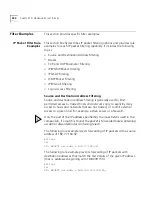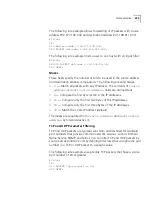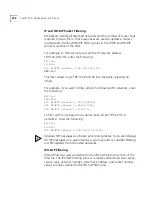
Creating Filters
225
3
Enter the protocol rules for the protocol section you are defining. Be sure
to perform the following:
■
Begin each rule with a unique line number (1-999).
■
Arrange rules in increasing order within each protocol section.
■
Arrange rules so that the rules you expect to be matched
most
frequently
are at the top of the list.
■
Delimit each rule with a semi-colon (;).
Example:
#filter
IP:
010 ACCEPT src-addr = 128.100.033.001;
020 ACCEPT dst-addr = 200.135.038.009;
4
Add filtering action if different from the default value of
PERMIT
.
Example:
030 DENY;
5
Continue to define protocol rules for each protocol section you want to
filter. Then, check the file to ensure it meets the RAS 1500 requirements
and save the file.
To set up RADIUS filter files, see Chapter 12 “Using Security and
Accounting”.
6
Access the CLI on the RAS 1500. Configure your computer as a TFTP
client by entering the following command:
add TFTP client <hostname or IP address>
7
Return to your computer. From a machine that has access to the same
network as the RAS 1500, use the following TFTP commands to transfer
the filter file to the RAS 1500 FLASH memory.
tftp <RAS 1500 IP address>
put <filter_filename>
Summary of Contents for REMOTE ACCESS SYSTEM 1500
Page 14: ......
Page 40: ......
Page 58: ......
Page 120: ......
Page 130: ......
Page 158: ......
Page 178: ......
Page 202: ......
Page 266: ......
Page 286: ......
Page 292: ......
Page 297: ...INDEX 295 V 90 151 W Windows 95 Dial Up Networking 89 World Wide Web WWW 285 X X 75 152 ...
Page 298: ...296 INDEX ...






























